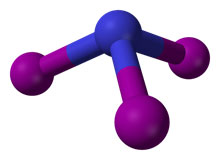
Sometimes a compound’s formula is given to you and you must determine the name of that compound. Other times you will be given the chemical name and must determine the formula.
How can you tell by reading the name of the covalent compound that it is a covalent compound?
The presence of prefixes in a name indicates a covalent compound. Ionic compounds do not have prefixes as a part of their naming convention. (You will learn more about naming ionic compounds in lesson 7 of this module.)
In the previous section, you learned the steps to naming covalent compounds. When you are given the name of the compound, reverse the steps to finding the formula.
Step 1: Look at the root names to determine the element and its symbol.
Step 2: Use the prefixes to determine the number of atoms of each element.
Let’s look at the name nitrogen triiodide.
First, analyze the roots to determine what elements are involved.

Source: nitrogen triiodide, Wikimedia commons
What are the two elements in nitrogen triiodide?

Next, analyze the prefixes to determine the number of atoms for each element that are present in nitrogen triiodide.
How many atoms of each element are in nitrogen triiodide?

What is formula for nitrogen triiodide?